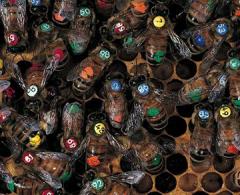
This Article From Issue
May-June 2006
Volume 94, Number 3
Page 219
DOI: 10.1511/2006.59.219
Rats Reveal a New Talent: "Stereo Smell"
Rats' nostrils are only 3 millimeters apart, but they appear to use them independently, localizing the source of an odor much as humans locate the source of a sound. Biologists in Bangalore trained rats to respond to odors on their left or right by drinking from a corresponding water spout. The rats required only 50 milliseconds—a single sniff—to make the decision, with 80 percent accuracy. When one nostril was covered, the localization ability was lost, which implies that rats' brains normally compare the signals from each nostril in order to create a spatial understanding of the environment.
Bhalla, U. Rats smell in stereo. Science 311:666–670 (February 3).
Master Genes More Likely to Mutate in Humans than Chimps
The figure is familiar: A whopping 99 percent of human genes are the same as those found in chimpanzees. Conspicuous diversities in the face of all that genetic compatibility have puzzled geneticists for as long as they have known the number. Now scientists have determined that many of the genetic mutations that differentiate people from chimps have occurred in master genes. These key genes regulate arrays of other genes by switching them on and off, resulting in lots of evolutionary bang for the buck. In liver tissue taken from humans, chimps, orangutans and rhesus macaques, genetic mutations among the regulatory genes were four times more likely to occur in humans than in the other primates.
Gilad, Y., et al.Expression profiling in primates reveals a rapid evolution of human transcription factors. Nature 440:242 – 245 (March 9).
Otterlike Fossil Challenges Timetable of Mammal Evolution
A new Chinese fossil find lends support for a dramatic revision of the evolution of early mammals. Paleontologists had believed that only small shrewlike creatures had coexisted with the dinosaurs and that larger mammals did not emerge until the giant reptiles died out 65 million years ago. But the remains of a foot-long fur-bearing aquatic mammal, Castorocauda lutrasimilis, show that larger mammals existed 164 million years ago. The new fossil, which had a beaver's tail and a seal's teeth, was found in Inner Mongolia's Ningcheng county, northeast of Beijing.
Ji, Q. A swimming mammaliaform from the middle Jurassic and ecomorphological diversification of early mammals. Science 311:1123–1127 (February 24).
Ponder Unconsciously for the Best Decision
If you're faced with a complex decision, the best course may be to focus on another task and let your unconscious work it out—or even simply to follow your first impulse.
That's the conclusion of a new study that tried to uncover the relationships among a decision's complexity, the amount of time spent consciously deliberating about it and the subject's final satisfaction. In choosing which of four hypothetical cars to buy, students chose well when they consciously considered a list of four attributes, such as leg room and mileage. When that list was increased to 12 attributes, however, better decisions were reached by a group of students who were asked to do distracting puzzles instead of thinking about the choice.
Dijksterhuis, A. On making the right choice: The deliberation-without-attention effect. Science 311:1005–1007 (February 17).
After Robins Fly South, Mosquitoes Spread West Nile Virus
Monitors of the West Nile virus in America should watch for the late summer-early fall departure of the red-breasted robin. The robin is the favorite food source of the Culex pipiens mosquito, which carries the virus. In the birds' absence, the mosquitoes turn to humans. A study has found that mosquitoes feed on people at a rate seven times higher in the late summer than they do in the early summer. In fact, the number of human cases of West Nile in the U.S. is highest in the months of August and September.
Kilpatrick, A. M. West Nile virus epidemics in North America are driven by shifts in mosquito feeding behavior. PLoS Biology 4:e82 (April).
Geysers on Saturn's Moon Enceladus
Saturn's moon Enceladus contains geysers that spout icy crystals, a strong suggestion that liquid water lurks in pools beneath the surface. The phenomenon adds Enceladus to the solar system's really short list of places that could conceivably host life. The geysers turned up in images taken by NASA's Cassini spacecraft as it buzzed by the moon's south pole. Astronomers had believed that Enceladus, only 300 miles wide, was likely a frozen piece of rock. Instead, the new observations show that it potentially possesses all of the elements that life needs to exist—water, relative warmth and carbon-based molecules.
Porco, C. Cassini observes the active south pole of Enceladus. Science 311:1393–1401 (March 10).
Immunity Linked to Brain Growth
Scientists have found evidence that bolstering the immune system may also shore up the brain against the onset of age-related learning and memory problems. The culprit: T-lymphocytes, cells that course through the blood stream attacking invaders. The cells were believed to act the same way in the brain, but it turns out that they may perceive a whole host of things they encounter in the brain as infectious, including normal brain proteins. The study posits that when T-lymphocytes misjudge these normal proteins, they begin to produce microglia, cells that promote inflammation. In the brain—particularly in the hippocampus, the seat of learning and memory—the microglia have the added benefit of boosting the development of new neurons.
Ziv, Y., et al. Immune cells contribute to the maintenance of neurogenesis and spatial learning abilities in adulthood. Nature Neuroscience 9:268 – 275 (February 1) .

American Scientist Comments and Discussion
To discuss our articles or comment on them, please share them and tag American Scientist on social media platforms. Here are links to our profiles on Twitter, Facebook, and LinkedIn.
If we re-share your post, we will moderate comments/discussion following our comments policy.